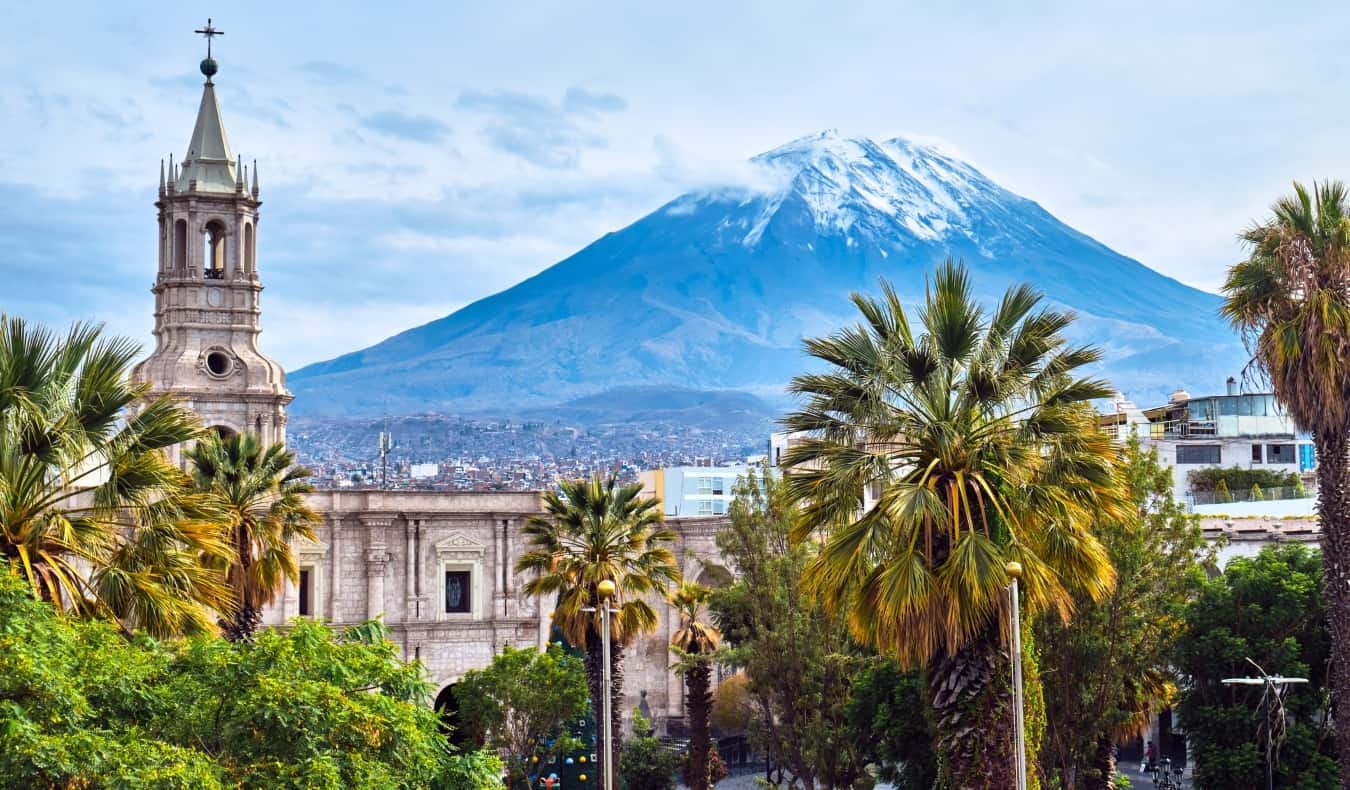The historic ruin of Ancient Corinth is one of the best and easiest day trips you can take from Athens.
We actually enjoyed this more than the Acropolis, which is extremely crowded with tourists. Corinth is a lesser known place to see some amazing ruins and artifacts in what used to be one of the major cities of classical Greece.
For Christians, Corinth is especially interesting because you can walk in the footsteps of the Apostle Paul, who spent 18 months there as a missionary, and famously wrote the letters of First and Second Corinthians.
This travel guide will explain how to get to Corinth on a day trip from Athens, and what to expect when you visit!
Where Is Corinth?
Corinth is located at the entrance to the Peloponnese peninsula, about 80 kilometers west of Athens.
However, the ruins of Ancient Corinth are located outside of modern Corinth town, so they’re about 8 kilometers further southwest.
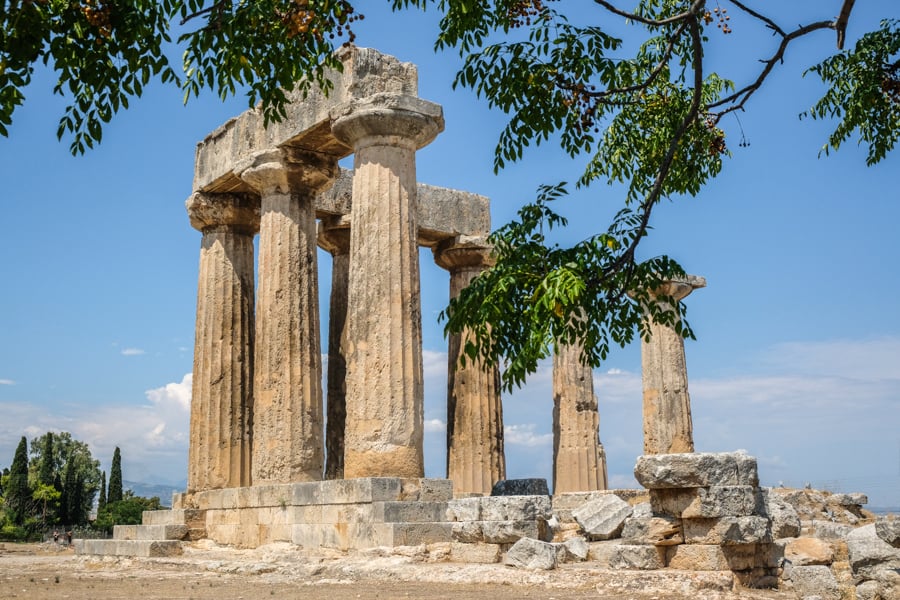
Temple of Apollo at Ancient Corinth
How To Get To Ancient Corinth
• By Tour
The quickest and easiest way to get to Corinth is with a tour.
GetYourGuide has half day guided tours from Athens to Corinth by bus, or they have full day tours that include a visit to the picturesque city of Nafplio.
We’ve used GetYourGuide for lots of tours and activities around the world, and they’re great. Highly recommended!
Book Now: Corinth Half Day Tour / Full Day Tour
• By Train
There’s a train route directly from Athens to Corinth, with departures every 2 hours at Larissa station (map here).
When we traveled to Corinth by train, we bought our tickets at the station in Athens. The ride is comfortable and takes about 1 hour.
Once you arrive at Corinth train station (map here), you’ll need to take a taxi to the ruins.
Taxis are easy to find at the train station, and there are also plenty of them at the ruins for your return trip. It’s a 10 minute drive from the station to the ruins.
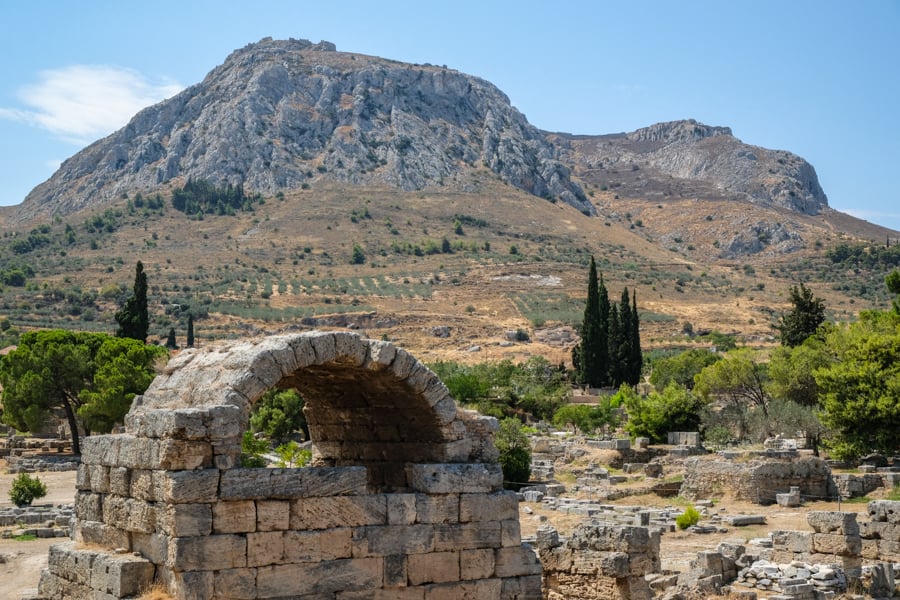
City ruins with the hill of Acrocorinth in the background
• By Bus
The KTEL company operates an hourly bus from Athens to Corinth that leaves from the Kifisou station (map here) and arrives at Isthmus bus station, near the canal (map here). The ride takes about 1 hour.
You can check the bus schedule and buy tickets on the KTEL website here. The bus also goes to Corinth town, but that’s not any closer to the ruins than Isthmus station, so it’s generally quicker and better to get off at Isthmus station.
Another advantage of doing it like this is that you can easily walk to the Corinth canal if you want, since it’s only 100 meters from the Isthmus station.
As with the train, you’ll need to hire a taxi to take you from the bus station to Ancient Corinth. It’s a 15 minute drive.
• By Car
If you rent a car in Athens (or elsewhere), you can drive to Corinth yourself. This is the most flexible way to visit the Corinth area.
The highway is in good condition, and it takes about 1 hour to drive to either Corinth town or the ruins if you’re starting from Athens.
There are many companies offering car rentals in Greece, but we recommend DiscoverCars! We used them for our own trip.


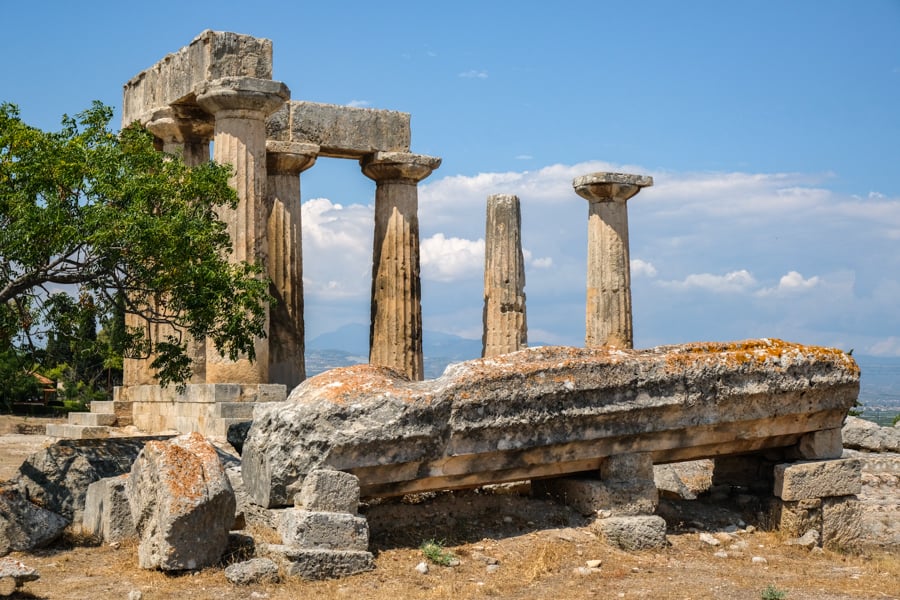
Fallen column
What To See At Ancient Corinth
• Temple Of Apollo
The first thing to see at Corinth is the Temple of Apollo, with its iconic Greek columns. It was built around 560 BC, and even though only a handful of its columns are standing, it’s still impressive.
This spot is especially beautiful when it’s framed by the mountain of Acrocorinth in the background, and it feels a little bit like you’re at the Acropolis of Athens, except without the crowds.
No offense to the Parthenon of Athens, but it can be extremely crowded, and half of it was covered in scaffolding when we visited. There were so many people we could barely walk. In contrast, we never saw too many people at Corinth.
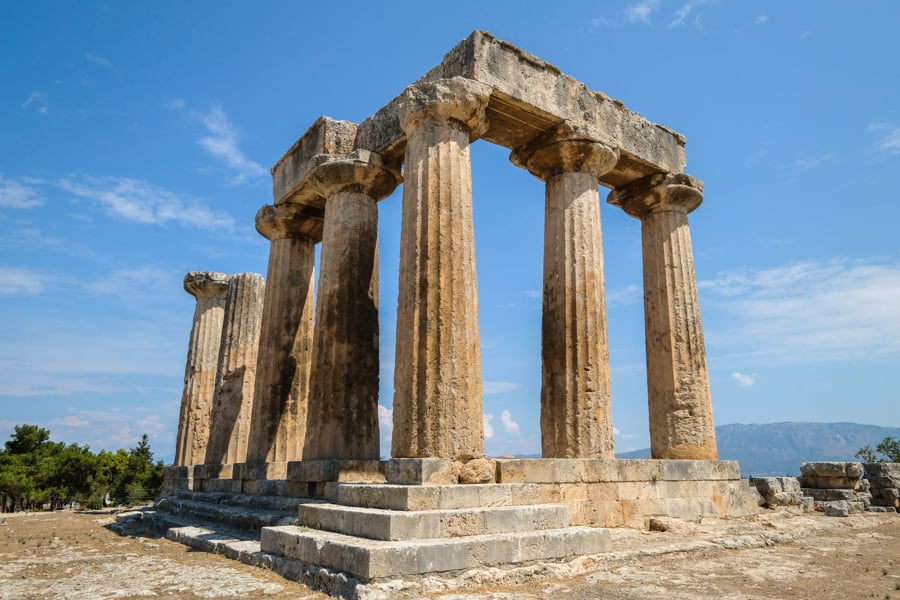
Temple of Apollo
• Fountain of Peirene
This ancient fountain served as a fresh water source for the city of Corinth, dating back as far as 500 BC.
Even though it isn’t close to its former grandeur, you can still imagine how beautiful it must have looked when the marble chambers were full of spring water.
• The Judgement Seat
This is an interesting place from Biblical history.
In the Bible, the Apostle Paul was brought to the judgement seat of Corinth and accused of teaching against Jewish law.
Gallio, the Roman Proconsul of Achaia, ultimately dismissed it as being out of his jurisdiction (Acts 18:12-16).
This judgement seat (bema) is the exact place where that happened, and there’s a sign explaining more information about it.
• Archaeological Museum of Ancient Corinth
After you’re done exploring the ruins at Ancient Corinth, there’s also a nice little museum located right at the archaeological site.
The museum has all kinds of great statues, mosaics, pottery, and other artifacts from the area, and even though it’s not a very big museum, it’s absolutely worth seeing!
There are plenty of signs in English so you can understand what you’re looking at, even if you don’t have a tour guide.
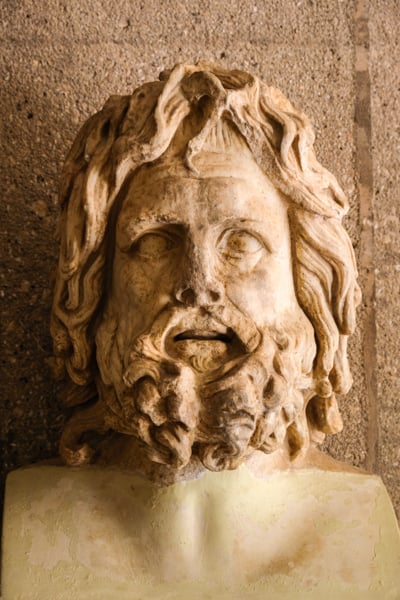
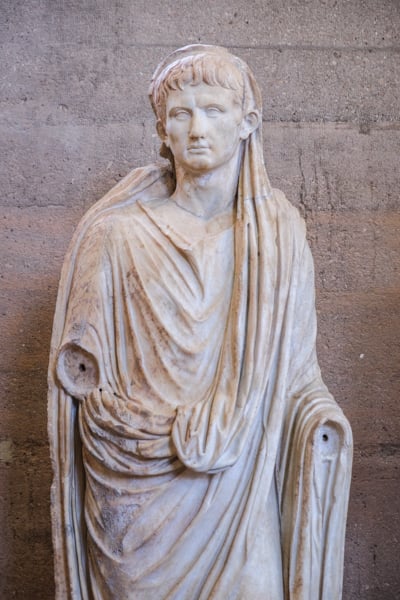
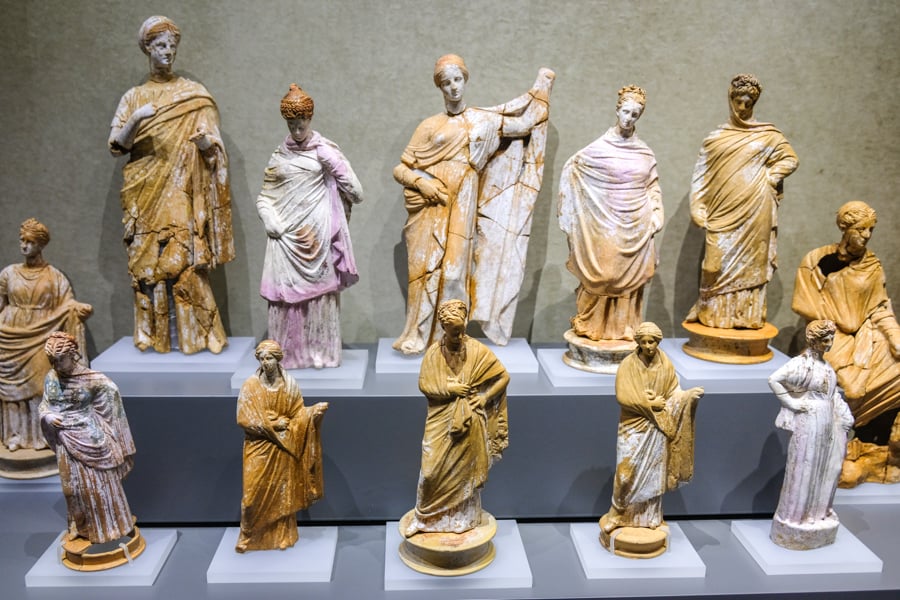
Figures at the museum
Opening Hours & Fees
- Summer hours (Apr 1 – Oct 31): 8 AM – 7 PM, or 8 AM – 8 PM (from May 1, 2024)
- Winter hours (Nov 1 – Mar 31): 8:30 AM – 3:30 PM, Tuesdays closed
- Summer entrance fee: 8€ full site or 4€ museum only
- Winter entrance fee: 4€ full site & museum
These are the current opening hours and entrance fees as of 2024, but you can check the official website for any changes.
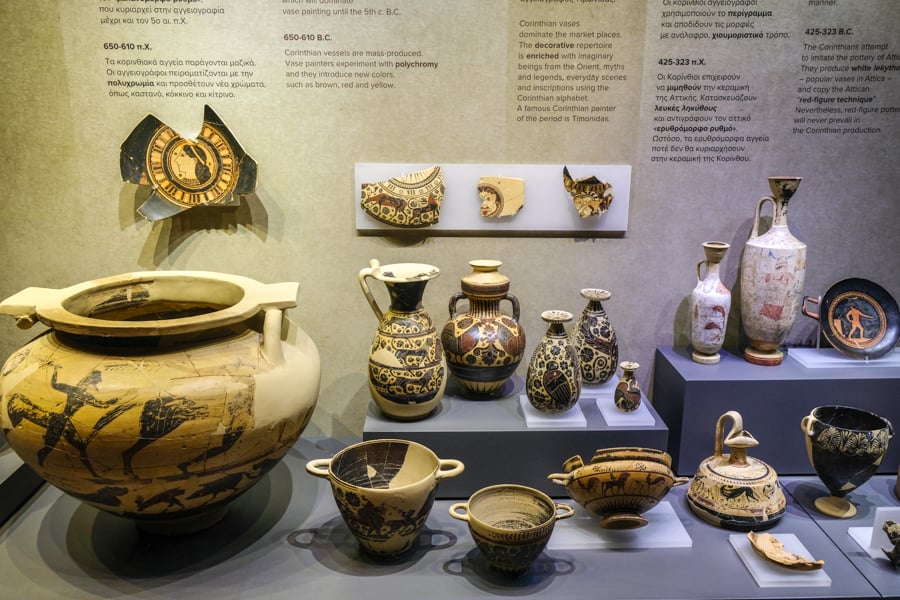
Corinthian pottery exhibits
How Long To Stay
I’d say you only need a couple of hours to explore the ruins and the museum at Corinth.
In total, that means you need at least half a day to visit the whole archaeological site, including the time spent on the way there and back from Athens.
If you want to see other things in the Corinth area as well, then you could turn it into a full day trip. See below for some suggestions.
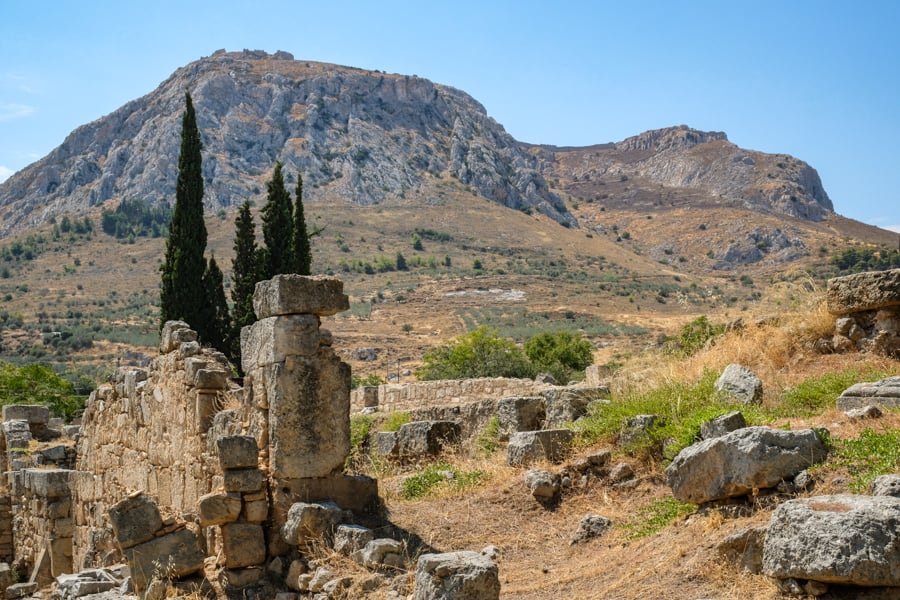
The perfect setting for a Greek city
Other Things To Do In Corinth
If you want to see some other things in Corinth while you’re visiting the ruins, here are a few ideas near the town:
- Acrocorinth. This is a big fortress on a hill that overlooks Ancient Corinth, with amazing views of the sea on both sides of the Isthmus. It’s a 5 minute drive from Ancient Corinth, but you’ll need 1 or 2 hours to do it justice. The terrain around the castle is all hilly and requires a bit of effort to navigate, so you’ll want to bring a cap and water.
- Paralia Kalamia. The main beach in modern Corinth. This is a nice pebbled beach with plenty of chairs, umbrellas, and sun beds. It’s 3 kilometers from the train station, so you can walk to it in about 30 minutes.
- Corinth Canal. This is a deep canal that was dug in the 19th century to allow ships to bypass the Peloponnese. It’s 8 kilometers east of Corinth, but you’ll pass it on your way there.
- Cenchreae Port. This is another ruin with Biblical significance. Cenchreae was the eastern port of Corinth, and it was used by the Apostle Paul, who shaved his head here to fulfill a vow (Acts 18:18). There’s not a lot to see here nowadays, but it’s a peaceful and interesting spot.
- Moni Agias Triadas. A picturesque monastery 8 kilometers south of Corinth.
- Paralia Loutra Oreas Elenis. This is another nice beach 15 kilometers southeast of Corinth. We went here and ate seafood by the beach.
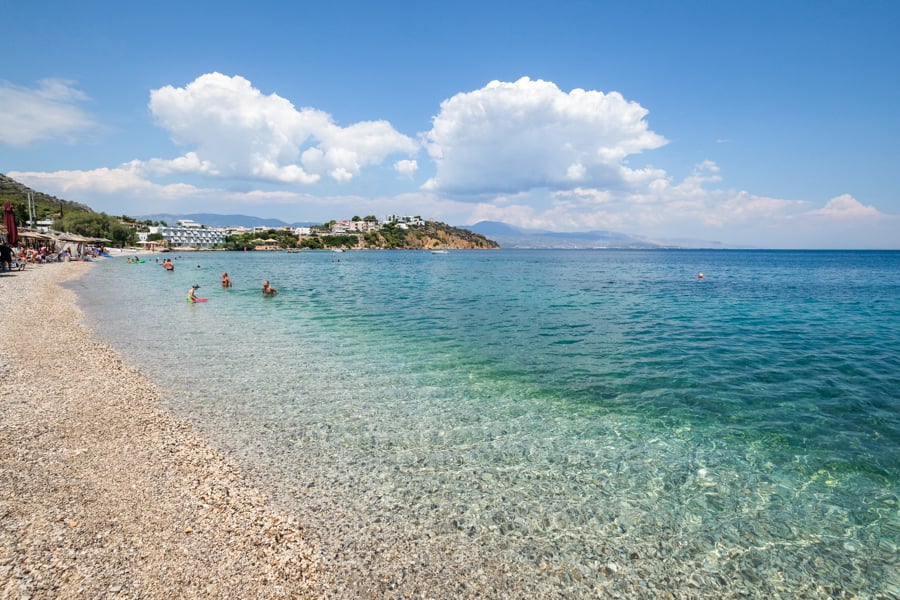
Beach at Loutra Oreas Elenis
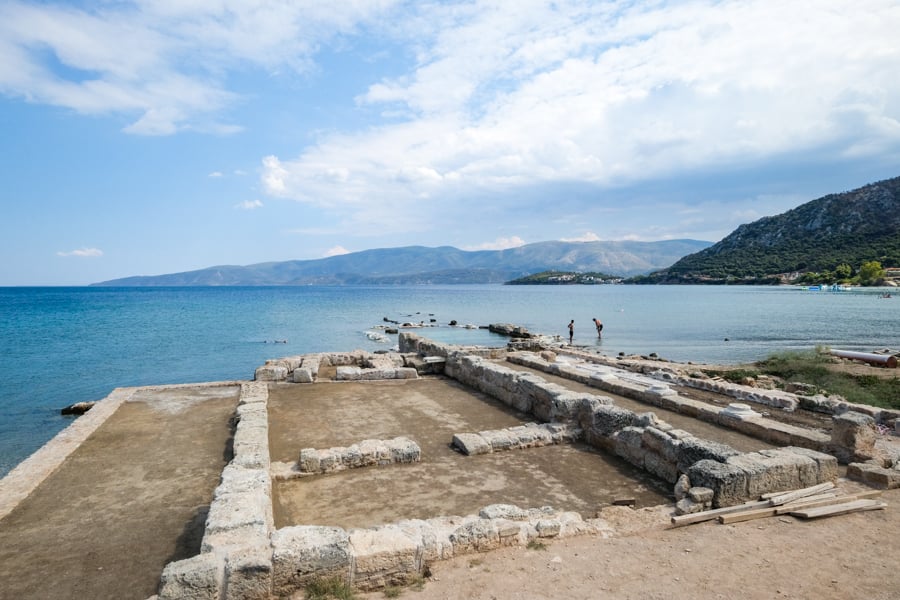
Remains of Cenchreae Port
More Travel Guides For Greece
Thanks for looking! I hope you enjoyed this guide for visiting Ancient Corinth on a day trip from Athens.
Don’t forget to check out my other travel guides for Greece, including the Greek islands of Santorini, Zakynthos, and Kefalonia!



